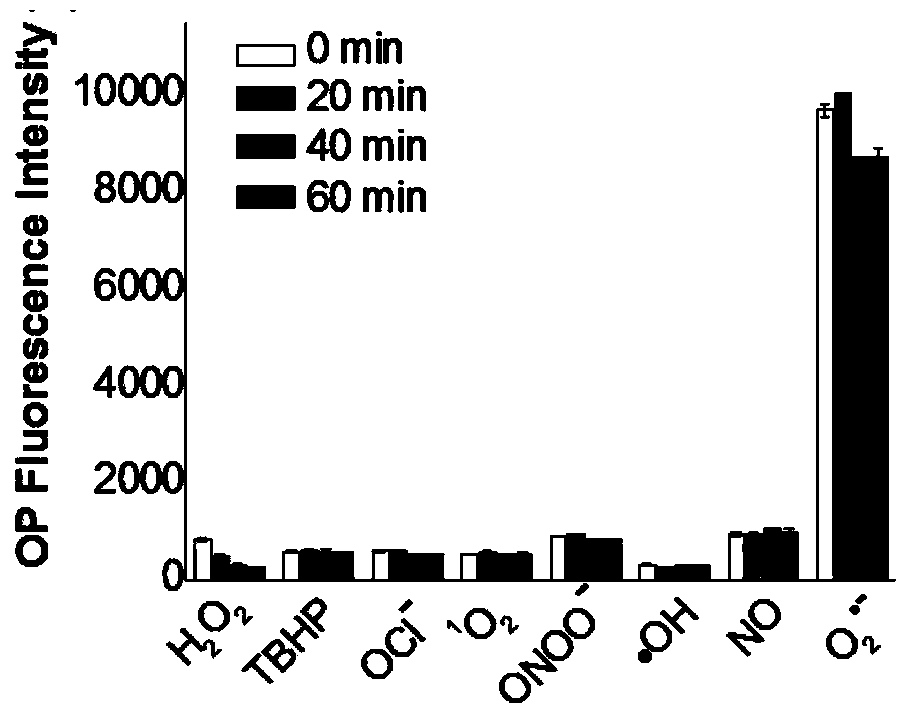Fluorescent probe and preparation method thereof, and application in detecting superoxide anions
A technology of fluorescent probes and synthesis methods, applied in the direction of fluorescence/phosphorescence, chemical instruments and methods, luminescent materials, etc., to achieve the effects of good chemical stability and photophysical stability, short response time, and simple synthesis steps
- Summary
- Abstract
- Description
- Claims
- Application Information
AI Technical Summary
Problems solved by technology
Method used
Image
Examples
Embodiment 1
[0029] Embodiment 1: the synthesis of probe I
[0030] Proceed as follows:
[0031] in N 2 Under protection, melamine (1.5 mmol) and caffeic acid (3.0 mmol) were dissolved in DMF and CH 2 Cl 2 The mixture (DMF 1.2mL, CH 2 Cl 2 6.0 mL), HOBT (0.636 g, 3.0 mmol) and EDC.HCL (0.576 g, 3.0 mmol) were added, and stirred at room temperature overnight (12 h). After concentrated by rotary evaporation to obtain the crude product, the product is separated and purified by a silica gel thin-layer chromatography plate. The preparation method of the silica gel thin-layer chromatography plate is: put 30g silica gel GF254 in a beaker, add 80ml of 0.5% sodium carboxymethyl cellulose aqueous solution, Make a paste. Pour the prepared slurry onto a clean and dry 20×20 glass slide, and dry it at room temperature for use; the eluent is a mixture of ethyl acetate-cyclohexane, wherein the volume ratio of ethyl acetate:cyclohexane It is 5:1. Finally, a light yellow product was obtained, namel...
Embodiment 2
[0034] Embodiment 2: the synthesis of fluorescent probe
[0035] in N 2 Under protection, melamine (1.0 mmol) and caffeic acid (3.5 mmol) were dissolved in DMF and CH 2 Cl 2 The mixture (DMF 2.0mL, CH 2 Cl 2 6.0 mL), HOBT (0.636 g, 3.0 mmol) and EDC.HCL (0.576 g, 3.0 mmol) were added, and stirred at room temperature overnight (12 h). After concentrated by rotary evaporation to obtain the crude product, the product is separated and purified by silica gel thin-layer chromatography. The preparation method of the silica gel thin-layer chromatography is the same as in Example 1; the eluent is ethyl acetate-cyclohexane mixed solution, wherein ethyl acetate : The volume ratio of cyclohexane is 4:1. Finally, a light yellow product is obtained, which is a fluorescent probe.
Embodiment 3
[0036] Embodiment 3: the synthesis of fluorescent probe
[0037] in N 2 Under protection, melamine (1.0 mmol) and caffeic acid (2.0 mmol) were dissolved in DMF and CH 2 Cl 2 The mixture (DMF 1.2mL, CH 2 Cl 2 5.0 mL), HOBT (3.5 mmol) and EDC.HCL (3.5 mmol) were added, and stirred at room temperature overnight (12 h). After concentrated by rotary evaporation to obtain the crude product, the product is separated and purified by silica gel thin-layer chromatography. The preparation method of the silica gel thin-layer chromatography is the same as in Example 1; the eluent is ethyl acetate-cyclohexane mixed solution, wherein ethyl acetate : The volume ratio of cyclohexane is 2:1. Finally, a light yellow product is obtained, which is a fluorescent probe.
PUM
 Login to View More
Login to View More Abstract
Description
Claims
Application Information
 Login to View More
Login to View More - R&D
- Intellectual Property
- Life Sciences
- Materials
- Tech Scout
- Unparalleled Data Quality
- Higher Quality Content
- 60% Fewer Hallucinations
Browse by: Latest US Patents, China's latest patents, Technical Efficacy Thesaurus, Application Domain, Technology Topic, Popular Technical Reports.
© 2025 PatSnap. All rights reserved.Legal|Privacy policy|Modern Slavery Act Transparency Statement|Sitemap|About US| Contact US: help@patsnap.com



